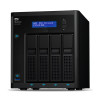Western Digital My Cloud PR4100 User Manual - Page 87
Windows Services, Share Aggregation
 |
View all Western Digital My Cloud PR4100 manuals
Add to My Manuals
Save this manual to your list of manuals |
Page 87 highlights
CONFIGURING SETTINGS Windows Services The Windows Services section of the Network screen allows you to configure Window Services applications on your My Cloud device. Workgroup The Workgroup feature allows devices in the same workgroup to access one another. This option is only available for Windows operating systems. Each time you add a device to your network, assign it the same workgroup name to enable access. 1. Enter the name of the WORKGROUP. 2. Click Apply. Local Master Browser The Local Master Browser feature allows you to collect and record resource and/or service information across multiple subnets. To enable/disable the Local Master Browser, click the toggle button to ON. Max SMB Protocol The Max SMB Protocol feature allows you to select the maximum Server Message Block (SMB) protocol you'd like to use for your device. Select the Max SMB Protocol from the drop-down menu. Share Aggregation Share aggregation (similar to Distributed File System [DFS]) consolidates shares from other My Cloud devices, or network devices that support the SMB protocol. Enabling this function allows you to improve data availability. Distributed File System is disabled by default. 1. To enable Share Aggregation, click the toggle button to ON. 2. In the Share Aggregation Settings window, enter the Root Folder Name to create a container for the linked, remote shares. Click Apply. 3. Click Add Link to connect to add links to aggregate remote shares. Enter the Local Folder Name for the folder displayed under the Root Folder. Enter the Remote Host hostname, or, the IP address of the target device. Manually enter the Remote Share name, or, click Get Remote Share Folder to display Remote Host shares. Click Apply. MY CLOUD USER MANUAL 81















